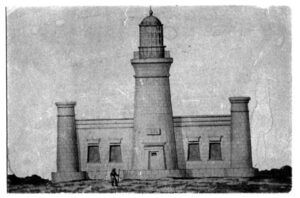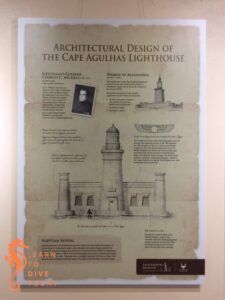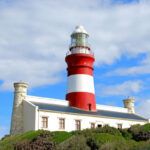Cape Agulhas lighthouse
The Cape Agulhas Lighthouse was the third lighthouse constructed in South Africa and is the second oldest that is still in operation. Cape Agulhas is the official dividing point between the Atlantic and Indian Oceans.
In the early 1840’s the local farmers appealed for the erection of a lighthouse. It was the farmers nearby who had the unenviable task of burying the dead and notifying authorities of any wrecks. It was thanks to their efforts that the Agulhas lighthouse was eventually commissioned on land donated by a local farmer.
For centuries, the Cape has been known to sailors as treacherous. The circumpolar current meets with the warmer Agulhas Current in the area of Cape Agulhas. These opposite water currents are of different densities, and with the west winds blowing it causes extremely dangerous wave conditions with gigantic wild waves, which can reach up to 30 metres high. These can sink even massive ships. The first of many recorded was the Zoetendal in 1673. A lighthouse was suggested in March 1837, by Colonel Charles Collier Michell, the Surveryor-General of the Cape. In July 1840, a public meeting was held to raise funds for the building of the lighthouse. The land was donated by Michiel van Breda, the founder of Bredasdorp. Col. Charles Cornwell Michell designed the lighthouse in homage to the Lighthouse of Alexandria. It has many Egyptian architectural characteristics, such as the pylon shape of the mock windows, the fake entrance resembling the Temple of Isis, similar frieze designs as depicted on temples and tombs in Egypt, and strong horizontal lines.
It took 90 men to build the lighthouse and it was first lit on the 1st of March 1849. Sheep tail fat was used as fuel. This was later replaced by an oil-burning lantern in 1905. A petroleum vapour burner was installed in 1929. Only in 1936 was a four-kilowatt electric lamp powered by a diesel generator used as the source of light. In 1962, this was replaced by an 18 million candlepower light.
It was declared unsafe and retired from service in 1968 due to the weathering of its sandstone walls so some restoration was done. The lighthouse was declared a national monument in 1973. It was fully renovated, restored, re-commissioned and automated in 1988. This is the only lighthouse museum in the country.


The current lighthouse comprises of a 27-metre round tower painted a solid red with a thick band of white in the middle. The focal plane of the light is 31 metres above high water and rotates, giving off a single bright, white flash every five seconds and can be seen for 30 nautical miles.
Climb to the top of the tower and see for miles and miles. The remains of the wreck of the Meisho Maru can still be seen just off the coast
Lighthouse Website


